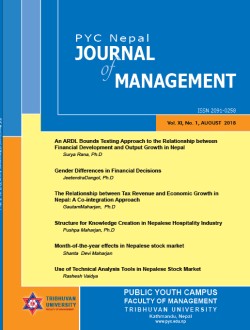Month-of-the-year Effects in Nepalese Stock Market
DOI:
https://doi.org/10.3126/pycnjm.v11i1.35919Keywords:
Calendar effect, Efficient Market Hypothesis, Month-of-the-year effectAbstract
The study investigates the month-of-the-year effects in Nepalese stock market employing composite index along with other nine sub-indices between mid-July 17, 2007 and mid-July 15, 2017. The study finds statistically significant highest average monthly returns in the month of Ashad (mid-June - mid-July) among other eleven months. On contrary, the significantly negative return is found in the month of Bhadra (mid-August - mid-September). It indicates that the Nepalese stock market has specific returns patterns showing inefficient in weak-form of market efficiency.
Downloads
Downloads
Published
How to Cite
Issue
Section
License
© Public Youth Campus

